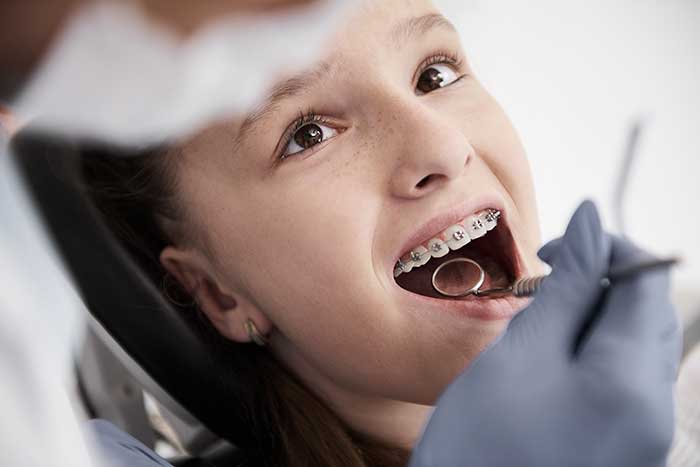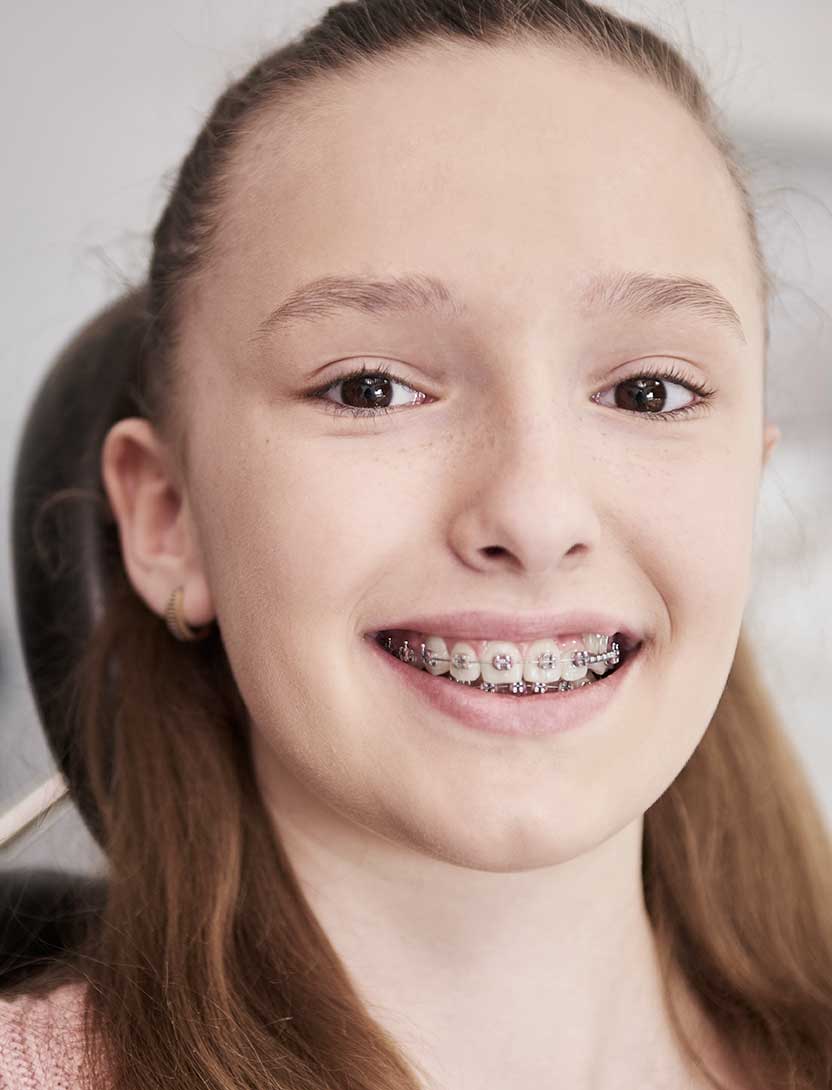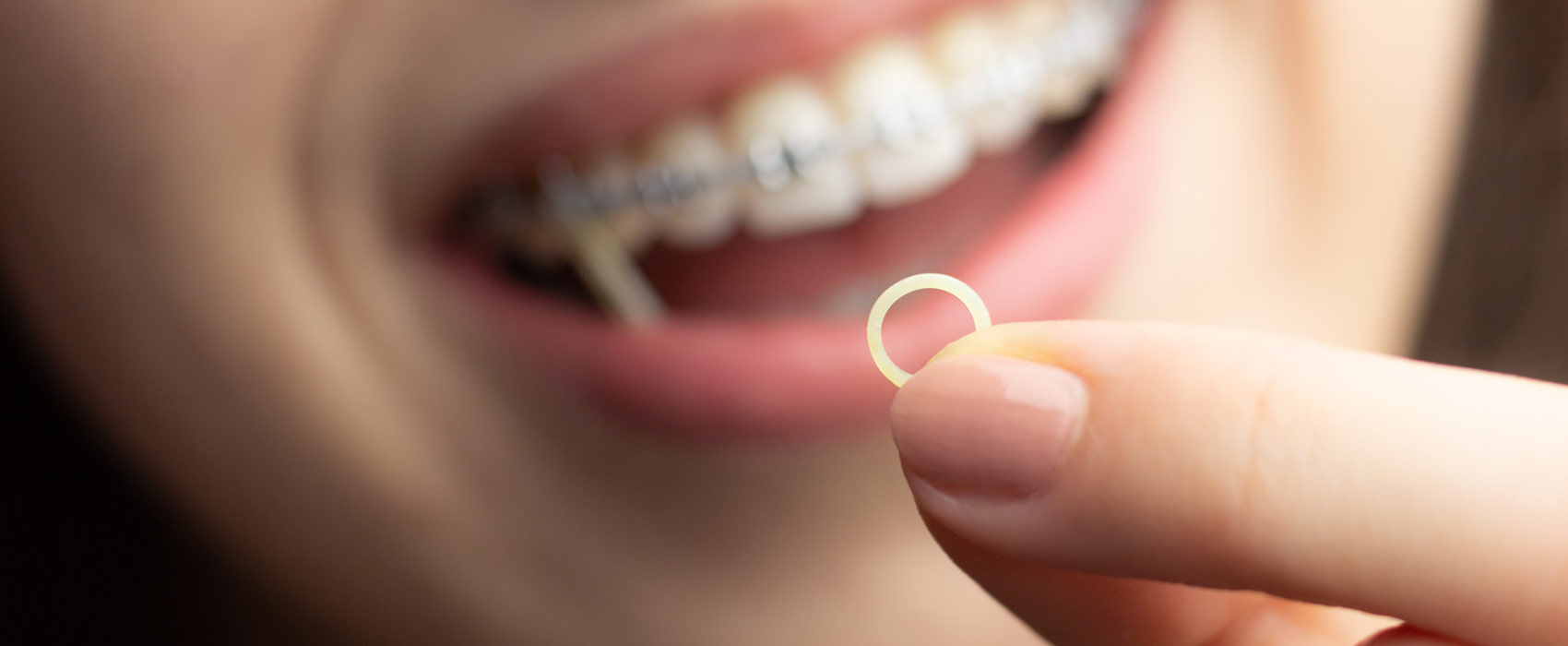The success of orthodontic treatment depends on the expertise and commitment of the orthodontist, as well as good communication with the patient. Patients who follow the orthodontist’s instructions and regularly come for check-ups can achieve wonderful results!
Raised awareness of the importance of a beautiful and healthy smile, as well as technological progress that resulted in aesthetic materials, have made fixed orthodontic appliance a generally accepted sign of self-improvement. Fixed orthodontic appliance (braces) is the most common, most effective, and most predictable mean of correcting orthodontic malocclusions. It consists of brackets placed on the teeth, tubes, or bands on the molars and an archwire.
Brackets transfer the forces exerted by the archwire (or another active element) on to the teeth and move them in the desired direction. It is essential that the brackets, in addition to being beautiful and inconspicuous, are meticulously crafted and therefore precise, because they contain information about the final position of the teeth, which determines the beauty of the smile. Brackets are placed on all the teeth except the molars, which are equipped with tubes or bands. The archwire passes through the horizontal slots of the brackets and, depending on the treatment stage, moves the teeth or serves as a guide for their sliding.
There are many different types of brackets out there and patients often have a hard time wading through all the information.
In her twenty years of work experience, dr. Vidaković has always approached every “new and revolutionary” invention with curiosity and open mindedness, but also with professional criticism and caution. Based on the scientific data and more than 3,000 successfully completed orthodontic treatments with various orthodontic appliances, dr. Vidaković emphasizes that the type of brackets does not determine the success of the treatment. The teeth are not moved by the brackets but by the orthodontist! The outcome of the treatment depends on the orthodontist’s knowledge, dedication, and experience, as well good communication with the patient.
Dr. Renata Vidaković works exclusively with the highest quality systems of classic, aesthetic and selfligating brackets from renowned world manufacturers: GC (Japan), Forestadent (Germany), G&H (USA). Depending on the type of anomaly, she will suggest the best choice, but the final decision is of course made by the patient.

Orthodontic treatment with a fixed appliance starts with the braces, after the initial examination and analysis of the collected diagnostic data and the presentation and coordination of the treatment plan with the patient/parents.
The braces are placed by a doctor of dental medicine specialising in orthodontics. After the braces are placed, check-ups are scheduled at 4, 6 or 8-week intervals, depending on the treatment stage. The orthodontist than assesses the progress of the treatment, decides and informs the patient of further steps, and prescribes the replacement of archwires or the adjustment of braces in order to keep applying light continuous force on the teeth with for maximum movement. At the orthodontic check-ups, we replace ligatures, check that their colours match😊, give instructions for maintaining hygiene and answer the patient’s questions and concerns.
The orthodontic specialist must be present at each orthodontic check-up.
When the therapy is completed according to all the professional criteria, i.e. when the individual optimum is reached and the patient can finally smile with confidence, we remove the braces! The teeth are then polished, and we take impressions or digital scans for the retainers, give retention instructions, admire the new smile and, of course, take pictures!! 😊

It is possible to feel some discomfort for a few days after getting the braces. The teeth may become sensitive to pressure or cold, and the brackets may irritate the inside of your cheeks and lips. During this period, it is particularly important to stay hydrated (drink enough water) to keep the mucous membrane of the oral cavity moist and more resistant to irritation. Those parts of the braces that cause irritation should be covered with silicone and thus allow the mucous membrane to recover quickly. Lingual braces are significantly more uncomfortable because they are placed on the inside of the dental arch, close to the tongue, which causes constant irritation. It is advisable to eat and drink lukewarm food and drinks and avoid anything too hot or cold. During the treatment, the teeth can become more mobile than usual, and after removing the braces they are stabilised and strengthened through retention. All the initial discomfort passes in a few days and patients quickly get used to their braces.
A healthy and balanced diet is always important – just as it is during orthodontic treatment. Adequate intake of all nutrients, minerals and vitamins is important for health in general, as well as for the health of the gums and the entire periodontium, for bone metabolism, and thus for orthodontic tooth movement. There is no need for patients undergoing orthodontic treatment to take additional minerals and vitamins if they have a healthy diet.
A few instructions for people wearing braces:
Sugar-free chewing gum is recommended for orthodontic patients because it stimulates the salivation which rinses the teeth, lubricates the mucous membranes (thus reducing irritation of the lips and cheeks), neutralises acidity and reduces the likelihood of caries.
The goal of orthodontic treatment is not only straight teeth, but a beautiful and healthy smile.
It is extremely important that patients maintain proper oral hygiene. That is why every orthodontic check-up must include checking the patient’s hygiene habits and advice on how to advance it to maintain and improve health.
Before positioning the bracket, the surface of the tooth is treated in a special way that enables firm adhesion of the bracket and prevents tooth decay under it. Despite professional preparation, caries can appear on any other tooth surface in case of poor oral hygiene.
The best practice is to thoroughly brush your teeth after each meal, cleaning the buccal, lingual and occlusal surfaces with enough pressure for the brush to reach the teeth and the spaces between them. Particular attention should be paid to the part of the tooth between the bracket and the gums, where plaque accumulates (food that after some time, decomposes into whitish mushy accumulations that corrode the enamel with their acid and bacteria, causing caries and inflammation of the gums – gingivitis). We recommend medium toothbrushes to most patients because toothbrushes with too soft bristles, although comfortable, are not firm enough to remove all food debris. Only adult patients with periodontal problems (gum surgery, recessions, or aggressive periodontitis) need a specialised programme recommended by either a periodontist or an orthodontist.
Dental floss, along with a toothbrush and toothpaste, is essential to maintain the health of your teeth and gums. It removes plaque between the teeth and under the gums, as well as in hard-to-reach places. We are always happy to demonstrate proper flossing technique.
Waterflossing is a welcome addition to oral hygiene, especially for patients with bridges, implants, or fillings, and can be very useful for orthodontic and/or periodontal patients.
After brushing, the teeth and all the parts of the braces must be shiny, polished and without any food debris.
A busy everyday life, school and business activities often do not allow us to thoroughly brush our teeth after every bite. Therefore, we need to remember that to prevent caries, it is enough to thoroughly brush our teeth two to three times a day, in front of a mirror, while during the day we can use an interdental or travel toothbrush to remove pieces of food and afterwards rinse our mouth with water. It is better to brush your teeth twice and do it properly, than to brush them a hundred times carelessly.
Intermaxillary elastics are small rubber bands connect teeth or groups of teeth in the same or opposite jaws in order to bring them into a harmonious relationship.
They exert a light but constant force and are an extremely important part of certain phases of orthodontic treatment. Most patients wear them in some stage of their treatment. Simply put, we first align the teeth and then use the elastics to correct the bite.
Depending on the malocclusion, elastics are placed on different teeth, thus exerting force in different directions. Elastics are available in different force levels, and when it comes to direction, they can be divided into class II and class III elastics, vertical, horizontal, diagonal and transversal- the combinations are countless. Patients are often instructed to wear a combination of several types of elastics at the same time…

Elastics should usually be worn continuously, that is, 24 hours a day, although variations are possible–during the night or 12 hours a day, depending on the case. It is essential to follow the orthodontists’ instructions to the letter, and in case of any ambiguities, additional clarifications should be sought to avoid unwanted side effects.
It is possible to eat while wearing certain combinations, however, we recommend that patients remove the elastics and put them back after meal. The elastics should certainly be removed before brushing your teeth. At the orthodontic check-up, we give the patient enough elastics to be able to change them after each removal.
Should the patient runs out of elastics, he/she should feel free to ask for more.
If the patient forgets to put on the elastics and does not bring them along, it is not advisable to double them the next day (wear two on the same teeth); instead, the treatment should continue according to the instructions given at the orthodontic check-up.
Elastics are an essential part of orthodontic treatment and the patient’s cooperation is crucial. If you follow the instructions, you can get great results!
Ortodoncija Vidaković
Cankareva 21, 10 000 Zagreb